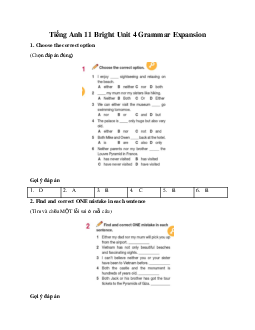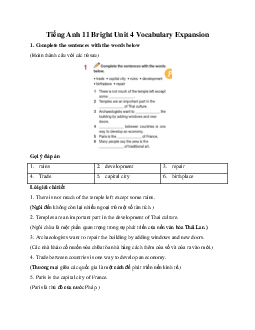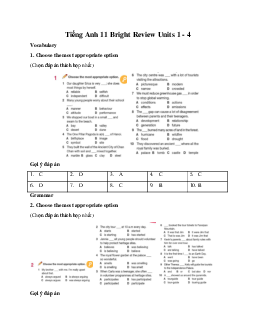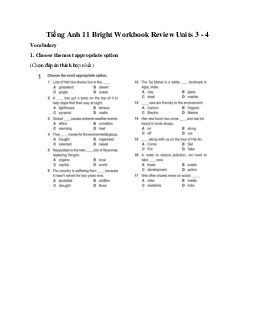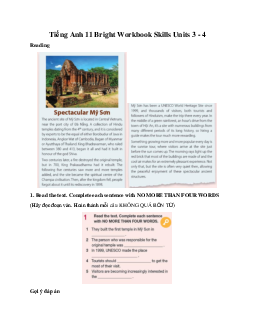





Preview text:
Tiếng Anh 11 Bright CLIL B
1. Where is the Great Barrier Reef? What problems does it face? Listen/Watch and read to find out.
(Rạn san hô Great Barrier ở đâu? Nó phải đối mặt với những vấn đề gì? Nghe/Xem và đọc để tìm hiểu.) Gợi ý đáp án
The Great Barrier Reef is along the northeast coast of Australia. Since 1985, it has lost
more than 50% of its coral, mostly because of global warming.
2. Read the text and decide if each of the statements (1-5) is T (true) or F (false).
(Đọc văn bản và quyết định xem mỗi câu (1-5) là T (đúng) hay F (sai).) Gợi ý đáp án 1. F 2. T 3. T 4. F 5. T
Lời giải chi tiết 1. F
Whales are the only marine animals in the Great Barrier Reef.
(Cá voi là loài động vật biển duy nhất ở Rạn san hô Great Barrier.)
Thông tin: It is home to 1,500 species of fish and 4,000 shellfish as well as 30 species of
marine animals such as whales, dolphins and sea turtles. The reef contains 400 types of
coral and more than 2,500 separate coral reefs.
(Đây là nơi sinh sống của 1.500 loài cá và 4.000 loài động vật có vỏ cũng như 30 loài
động vật biển như cá voi, cá heo và rùa biển. Rạn san hô chứa 400 loại san hô và hơn
2.500 rạn san hô riêng biệt.) 2. T
There are many different corals in the Great Barrier Reef.
(Có nhiều loại san hô khác nhau ở Rạn san hô Great Barrier.)
Thông tin: The reef contains 400 types of coral and more than 2,500 separate coral reefs.
(Rạn san hô chứa 400 loại san hô và hơn 2.500 rạn san hô riêng biệt.) 3. F
There was twice as much coral in the reef in 1985 as there is now.
(Có gấp đôi số lượng san hô trong rạn san hô vào năm 1985 so với hiện tại.)
Thông tin: Sadly, though, since 1985, the Great Barrier Reef has lost more than 50% of
its coral, mostly because of global warming.
(Tuy nhiên, đáng buồn là kể từ năm 1985, Rạn san hô Great Barrier đã mất hơn 50% san
hô, chủ yếu là do sự nóng lên toàn cầu.) 4. F
The main cause of coral bleaching is pollution.
(Nguyên nhân chính của hiện tượng tẩy trắng san hô là do ô nhiễm.)
Thông tin: As the Earth becomes warmer, ocean water temperatures increase and cause coral bleaching.
(Khi Trái đất trở nên ấm hơn, nhiệt độ nước biển tăng lên và gây ra hiện tượng tẩy trắng san hô.) 5. T
The Great Barrier Reef has become a protected marine park.
(Rạn san hô Great Barrier đã trở thành một công viên biển được bảo vệ.)
Thông tin: The good news is that 99% of the reef is now a marine park that protects the
coral by controlling tourism, fishing and leisure activities in the park.
(Tin tốt là 99% rạn san hô hiện là công viên biển bảo vệ san hô bằng cách kiểm soát các
hoạt động du lịch, câu cá và giải trí trong công viên.)
3. What do the following numbers in the text in Exercise 1 refer to?
(Các số sau trong đoạn văn ở bài tập 1 nói lên điều gì?) Gợi ý đáp án
- 50 refers to the percentage of coral that the Great Barrier Reef has lost since 1985.
- 99 refers to the percentage of the Great Barrier Reef that is now a marine park.
- 30 refers to the number of species of marine animals found in the Great Barrier Reef.
- 1,500 refers to the number of fish species found in the Great Barrier Reef.
- 348 refers to the size of the Great Barrier Reef in square kilometers.
- 4,000 refers to the number of shellfish species found in the Great Barrier Reef.
- 2,500 refers to the number of separate coral reefs that make up the Great Barrier Reef.
- 400 refers to the number of coral types found in the Great Barrier Reef.
- 1981 refers to the year the Great Barrier Reef was declared a World Heritage area.
4. Read the statements and find one more reason in the text.
(Đọc các câu phát biểu và tìm thêm một lý do trong văn bản.) Gợi ý đáp án
5. is now a protected marine park.
5. Use the ideas in Exercise 4 to say why coral reefs are important. Tell the class.
(Sử dụng những ý tưởng trong Bài tập 4 để nói tại sao các rạn san hô lại quan trọng. Nói với lớp.) Gợi ý đáp án
Coral reefs, such as the Great Barrier Reef, are incredibly important for a variety of
reasons. Firstly, they are home to a wide range of marine species. These species rely on
the coral reefs for food, shelter and breeding grounds. Secondly, coral reefs are of global
scientific and environmental importance, as they are incredibly diverse and provide a
natural laboratory for scientists to study. They are also an important indicator of the
health of the world's oceans. Besides, coral reefs are an incredible ecosystem, with a
delicate balance between the different species that inhabit them. Finally, the protection of
coral reefs is vital for the preservation of the Earth's natural history and amazing natural beauty. Project
6. Think of a natural feature in your country that is under threat. Collect
information under the headings name, its importance, the threats it faces and actions to protect it.
(Hãy nghĩ về một đặc điểm tự nhiên ở đất nước của bạn đang bị đe dọa. Thu thập thông
tin dưới tên tiêu đề, tầm quan trọng, các mối đe dọa mà nó phải đối mặt và các hành động để bảo vệ nó.) Gợi ý đáp án Name: The Amazon Rainforest Its importance:
The Amazon Rainforest is the largest tropical rainforest in the world, covering over 5.5
million square kilometers in South America. It is also known as the "lungs of the Earth"
because it produces 20% of the world's oxygen. The rainforest is also a vital resource for
indigenous communities, providing food, shelter, and natural medicine. The threats it faces:
The Amazon Rainforest faces several threats, including deforestation, mining,
agriculture, and climate change. Deforestation is the primary threat to the rainforest, as
large areas of forest are being cleared for farming. Mining operations also destroy vast
areas of the forest, affecting human health. Climate change is causing forest fires in the
Amazon, leading to further deforestation and loss of biodiversity. Actions to protect it:
There are several actions being taken to protect the Amazon Rainforest, such as
increasing enforcement of laws against illegal mining, and creating protected areas for
wildlife. International organizations are also working to reduce demand for products
linked to deforestation. In addition, individuals can reduce their consumption of products,
support conservation organizations, and raise awareness about the importance of
protecting the Amazon Rainforest.
